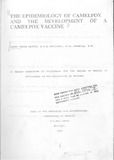| dc.description.abstract | The role of disease in camel husbandry is little understood although it is known that calf mortality is the most serious problem faced by the people who rear camels. Camelpox is the most serious viral disease affecting camel calves in many parts of the world but its clinical manifestation and prevalence have not been examined in Kenya. Camel contagious ecthyma, another closely related and sometimes indistinguishable condition to camelpox has also not been fully investigated. Basic biological characterisation of the camelpox virus has been performed but the propagation and
chemical composition of the camelpox virus have not been studied in
great detail as with other viruses. There are no reports of efforts at preparing effective vaccines against camelpox.
In this study, the prevalence and’ clinical manifestation of clinical camelpox as well as camel contagious ecthyma were studied in two main camel rearing districts of Samburu and Turkana in Kenya. Camelpox was found with equal frequency in these districts, but while it was found in two calf herds in Turkana, it was found ln two adult herds in Samburu. Camelpox exhibited itself as pox lesions affecting mainly the head where pustules were seen on the muzzle, lips and nostrils. Mandibular and cervical lymph nodes were
swollen. In the adults there was also severe oedema of the neck,
camel contagious ecthyma was found in four herds only in Turkana
where it affected camel calves. The lesions were mainly similar to
camelpox but was associated with secondary bacterial infection.
Goat kids in the herds of affected camels were also severely
affected. Camelpox virus was propagated on the chorio-aliantoic
membrane of embryonated chicken eggs,continuous cell lines(VERO and
BHK-21) and on several primary cells(sheep kidney, skin and lung
cells,calf kidney and thyroid cells). Sheep kidney cells were found
to be the most appropriate in the propagation of camelpox virus
where giant cell formation (syncytium) was prominent. Camelpox virus
was found to be non-pathogenic to several laboratory animals like
rabbits, mice, chicken and rats. Four polypeptides of camelpox
virus were identified after polyacrylamide gel electrophoresis.
Camelpox virus was inactivated with hydroxylaraine hydrochloride, ♦
acetylethyleneimine and formalin. Formalin was found to be a more suitable inactivant and was used to inactivate bulk camelpox virus. The prepared virus was then mixed with incomplete Freund's adjuvant and used to vaccinate rabbits which showed an increase in antibody titres against camelpox virus with no side effects. This vaccine was then used to vaccinate twenty camels while ten camels which were not vaccinated were used as controls. All camels were challenged after three weeks by intradermal scarification. The vaccinated camels had small skin lesions which healed within three days. The control camels which had not been vaccinated, had
significantly larger lesions which took about twenty days to heal. The antibody titre was significantly higher in the vaccinated animals than in the control animals.
It was concluded after the survey that camelpox was an important disease in Kenya but whose magnitude was not known before. Camelpox was found to not only affect whole herds, but also affected calves and adults. Camel contagious ecthyma was found in camel calves and mostly associated with caprine outbreaks of contagious ecthyma. Sheep kidney cells were found suitable in preparing bulk vaccine against camelpox. A formalin inactivated camelpox vaccine was found to be effective in protecting calves against the clinical disease. The vaccinates were found to be immune when challenged. | |

